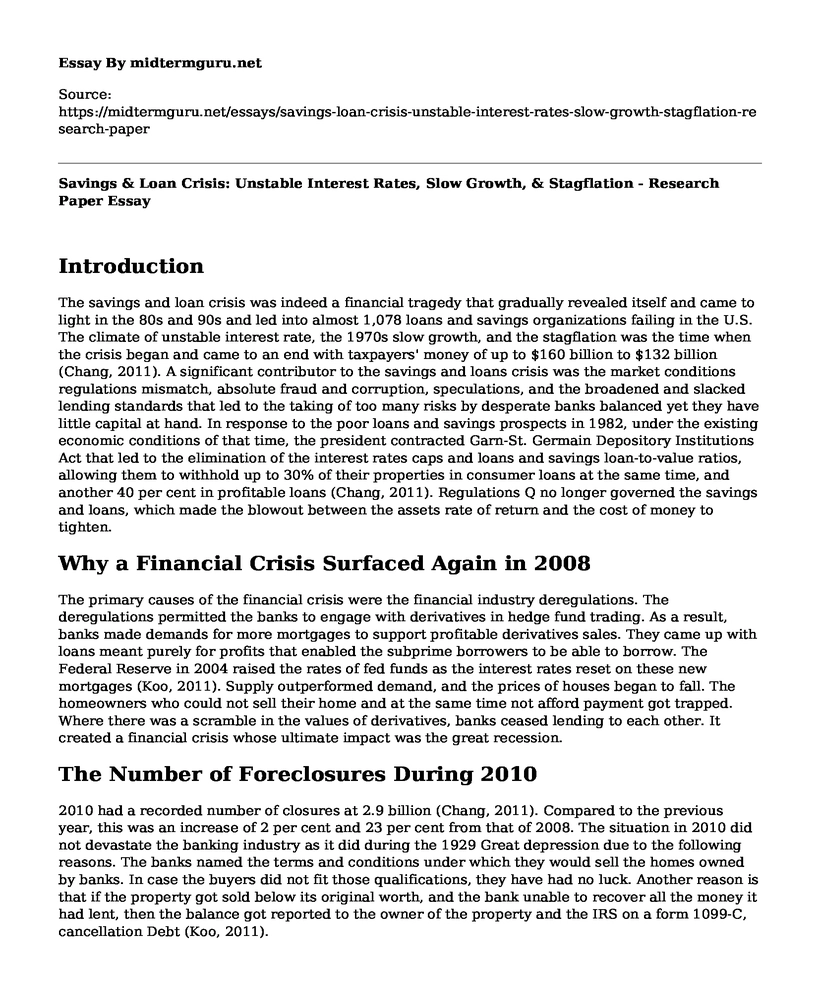Introduction
The savings and loan crisis was indeed a financial tragedy that gradually revealed itself and came to light in the 80s and 90s and led into almost 1,078 loans and savings organizations failing in the U.S. The climate of unstable interest rate, the 1970s slow growth, and the stagflation was the time when the crisis began and came to an end with taxpayers' money of up to $160 billion to $132 billion (Chang, 2011). A significant contributor to the savings and loans crisis was the market conditions regulations mismatch, absolute fraud and corruption, speculations, and the broadened and slacked lending standards that led to the taking of too many risks by desperate banks balanced yet they have little capital at hand. In response to the poor loans and savings prospects in 1982, under the existing economic conditions of that time, the president contracted Garn-St. Germain Depository Institutions Act that led to the elimination of the interest rates caps and loans and savings loan-to-value ratios, allowing them to withhold up to 30% of their properties in consumer loans at the same time, and another 40 per cent in profitable loans (Chang, 2011). Regulations Q no longer governed the savings and loans, which made the blowout between the assets rate of return and the cost of money to tighten.
Why a Financial Crisis Surfaced Again in 2008
The primary causes of the financial crisis were the financial industry deregulations. The deregulations permitted the banks to engage with derivatives in hedge fund trading. As a result, banks made demands for more mortgages to support profitable derivatives sales. They came up with loans meant purely for profits that enabled the subprime borrowers to be able to borrow. The Federal Reserve in 2004 raised the rates of fed funds as the interest rates reset on these new mortgages (Koo, 2011). Supply outperformed demand, and the prices of houses began to fall. The homeowners who could not sell their home and at the same time not afford payment got trapped. Where there was a scramble in the values of derivatives, banks ceased lending to each other. It created a financial crisis whose ultimate impact was the great recession.
The Number of Foreclosures During 2010
2010 had a recorded number of closures at 2.9 billion (Chang, 2011). Compared to the previous year, this was an increase of 2 per cent and 23 per cent from that of 2008. The situation in 2010 did not devastate the banking industry as it did during the 1929 Great depression due to the following reasons. The banks named the terms and conditions under which they would sell the homes owned by banks. In case the buyers did not fit those qualifications, they have had no luck. Another reason is that if the property got sold below its original worth, and the bank unable to recover all the money it had lent, then the balance got reported to the owner of the property and the IRS on a form 1099-C, cancellation Debt (Koo, 2011).
The Role Moral Hazard Took in Initiating the Foreclosure Crisis
The discussion on the widespread of the foreclosure has seen significant omission on the part of the failure to follow the legal procedures, which has not only led to the foreclosures but also lead to a breakdown in the formation and management of mortgage-backed securities. This is one of the examples of moral hazard consequences deeply ingrained in how the financial markets function. The functioning of the financial industry is on the assumption that activities and assumptions that are unenforceable or illegal under the current law will always be retroactively made legal as long as they involve significant liabilities or bank loses. This is the failure which led to the foreclosure in 2010 (Koo, 2011).
References
Chang, W. W. (2011). Financial crisis of 2007-2010. Available at SSRN 1738486. https://papers.ssrn.com/sol3/papers.cfm?abstract_id=1738486
Koo, R. C. (2011). The holy grail of macroeconomics: Lessons from Japan's great recession. John Wiley & Sons. https://books.google.com/books?hl=en&lr=&id=ui9Bj0u_khUC&oi=fnd&pg=PT7&dq=great+recession+1929&ots=XvNOmm8RAK&sig=w9ylrmj7J4ZnfnhA-rroOxczUqs
Cite this page
Savings & Loan Crisis: Unstable Interest Rates, Slow Growth, & Stagflation - Research Paper. (2023, Jan 11). Retrieved from https://midtermguru.com/essays/savings-loan-crisis-unstable-interest-rates-slow-growth-stagflation-research-paper
If you are the original author of this essay and no longer wish to have it published on the midtermguru.com website, please click below to request its removal:
- The Marketing Mix and Dynamic Pricing - Paper Example
- Evaluation Essay on Tom's Shoe Company
- Financial Performance of Omani Banks: A Literary Analysis Essay
- Cost Estimation: Key to Longevity of Construction Companies - Essay Sample
- Activision Blizzard SWOT Analysis: Strengths, Weaknesses, Opportunities, & Threats - Research Paper
- 3-Level Appraisal System for Optimal Employee Performance - Essay Sample
- HP: Corporate Politics Affecting CEO Changes Since 2005 - Essay Sample







